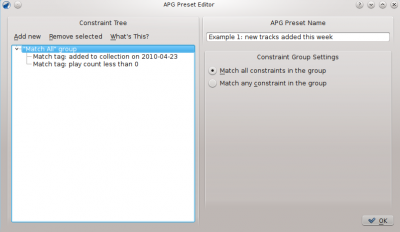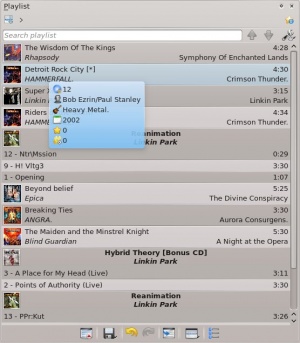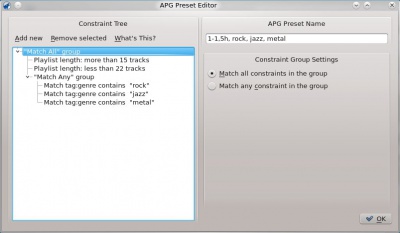Amarok/Manual/Playlist/AutomaticPlaylistGenerator: Difference between revisions
Pedromundo (talk | contribs) |
m (Updated for 2.8) |
||
| (51 intermediate revisions by 10 users not shown) | |||
| Line 1: | Line 1: | ||
<languages/> | |||
<translate> | |||
= | === Automatic Playlist Generator === <!--T:1--> | ||
The ''Automated Playlist Generator | <!--T:2--> | ||
The '''Automated Playlist Generator (APG)''' automatically generates playlists based on constraints you set. These constraints can be set based on song data (artist, genre, year) or access time (last played). There are also special constraints to determine how '''Amarok''' is going to look for songs. You will find the ''APG'' in your '''Media Sources''' pane, <menuchoice>Playlists -> Automated Playlist Generator</menuchoice>. | |||
==APG Presets | ==== APG Presets Toolbar ==== <!--T:3--> | ||
[[File: | <!--T:4--> | ||
[[File:Amarok-apg-presets-toolbar.png|center]] | |||
This is the APG Presets' toolbar | <!--T:5--> | ||
This is the '''APG Presets''' toolbar. From left to right we have the following buttons: | |||
* | <!--T:21--> | ||
* {{Plus}} Adds a blank preset that can be modified. | |||
<!--T:22--> | |||
* {{Icon|document-properties}} Opens up the '''APG Preset Editor''' window to edit the currently selected preset constraints. | |||
<!--T:23--> | |||
* {{Minus}} Removes the selected preset from the list; can ''not'' be undone. | |||
<!--T:24--> | |||
* {{Icon|document-import}} Import a preset from a .xml file. Has the potential to be malformed if edited outside '''Amarok'''; use the constraint tester. | |||
<!--T:25--> | |||
* {{Icon|document-export}} Export the selected preset to a .xml file that can be imported. | |||
<!--T:27--> | |||
* {{Icon|go-next}} Loads '''APG''' with the selected preset and automatically generates a playlist. | |||
==== Working with Presets ==== <!--T:6--> | |||
<!--T:7--> | |||
[[File:APGpresetsMatchAllGroup.png|400 px|center|thumb|APG Preset Editor window]] | |||
Amarok' | <!--T:8--> | ||
Presets are sets of rules that '''Amarok''' '''APG''' will use when generating playlists. These rules are going to be referred to as ''constraints'' from now on; every preset is determined by the constraints which create it. Groups of constraints hierarchically and logically organized are called constraint trees. | |||
===== Constraints ===== <!--T:9--> | |||
<!--T:10--> | |||
Constraints are the building blocks of constraint trees. They are simple statements that the '''APG''' will use to add songs to the playlist it generates. To add a constraint to the currently selected preset constraint tree click the {{Icon|document-properties}} button in the '''APG Preset toolbar''' and click the <menuchoice>Add new</menuchoice> option on the '''APG Preset Editor''' window. Note that this will add the constraint under the selected item (constraint or constraint group).<br /><br /> | |||
Many different kinds of constraints can be added; each works in a different way inside the tree. | |||
===== Constraint Types ===== <!--T:11--> | |||
<!--T:12--> | |||
'''Amarok''' '''APG''' supports several types of constraints: | |||
{| <!--}--> | |||
! Constraint !! Description</translate> | |||
|- | |||
<translate> | |||
<!--T:28--> | |||
| <menuchoice>Match Tags</menuchoice> || The most important constraints, because they can be set to virtually any information regarding the file, including: artist name, album name, genre, year, last played, and score.</translate> | |||
|- | |||
<translate> | |||
<!--T:29--> | |||
| <menuchoice>Playlist Duration</menuchoice> || Set the running time (in HH:MM:SS format) that the playlist should have</translate> | |||
|- | |||
<translate> | |||
<!--T:30--> | |||
| <menuchoice>Playlist Length</menuchoice> || Determine how many songs should be in the playlist</translate> | |||
|- | |||
<translate> | |||
<!--T:31--> | |||
| <menuchoice>Checkpoint</menuchoice> || Tell '''Amarok''' where to start and stop looking for tracks</translate> | |||
|- | |||
<translate> | |||
<!--T:32--> | |||
| <menuchoice>Prevent Duplicates</menuchoice> || Prevent '''Amarok''' from selecting the same tracks, songs from the same artist, or the same album | |||
|} <!--{--> | |||
<!--T:13--> | |||
Note that you can change how constraints work in various manners, such as setting the fuzzy-exact slider, which determines how closely the constraint is going to be followed. | |||
<!--T:33--> | |||
Another way to modify constraints that is present on <menuchoice>Match Tags</menuchoice> with a textbased tag is found in the line below the <menuchoice>Field</menuchoice> option box. In the text field to the right you write the text to be matched and in the option box at the left of the value you can select <menuchoice>contains</menuchoice> (which will consider any songs that have the according text in their tag), <menuchoice>matches</menuchoice> (which will consider songs whose corresponding tag match exactly the one in the text box), <menuchoice>starts with</menuchoice> and <menuchoice>ends with</menuchoice>. | |||
<!--T:34--> | |||
Similarly, you can also edit the way value-based constraints (such as the <menuchoice>Playlist Length</menuchoice> constraints and the playcount <menuchoice>Match Tag</menuchoice> constraint) behave by changing the option close to the text to settings such as <menuchoice>fewer than</menuchoice>, <menuchoice>equals</menuchoice> and <menuchoice>more than</menuchoice>. | |||
<!--T:35--> | |||
Another way to change constraint behavior is to check the <menuchoice>invert</menuchoice> checkbox on them, this makes them behave the opposite way, a "Match Tag: artist contains '''''name'''''" becomes "Match Tag: artist not contains '''''name'''''". | |||
===== Constraint Groups ===== <!--T:14--> | |||
<!--T:15--> | |||
Constraint groups can be added from the <menuchoice>Add new</menuchoice> option from the '''APG Preset Editor''' window, constraints under a group are logically linked, the same applies to groups under groups. | |||
There are currently two kinds of constraint groups: "Match all" groups and "Match any" groups. "Match all" groups require that all the constraints under them are met by the song. "Match any" groups require that at least one of the constraints under them are met by the song. To add a constraint under a specific group highlight it on the preset editor and use the <menuchoice>Add new</menuchoice> option. | |||
==== Using your Presets ==== <!--T:16--> | |||
<!--T:17--> | |||
Once you set up a preset, you just have to select it on the '''APG Presets''' panel in the '''Automated Playlist Generator (APG)''' and click {{Icon|go-next}} the toolbar to run '''APG''' with the selected preset. You will then have a playlist matching your criteria, like this: | |||
<!--T:18--> | |||
[[Image:Generatedlist.jpeg|thumb|300 px|thumb|center|Playlist generated by the constraint tree below.]] | |||
[[Image:Generatingtree.jpeg|thumb|400 px|center]] | |||
<!--T:19--> | |||
{{Prevnext2 | {{Prevnext2 | ||
| prevpage= | | prevpage=Special:myLanguage/Amarok/Manual/Playlist/DynamicPlaylists | nextpage=Special:myLanguage/Amarok/Manual/Various | ||
| prevtext= | | prevtext=Dynamic Playlists | nexttext=Various | ||
| index= Amarok/Manual | indextext=Back Menu | | index=Special:myLanguage/Amarok/Manual | indextext=Back to Menu | ||
}} | }} | ||
<!--T:20--> | |||
[[Category:Amarok2.8]] | |||
[[Category:Multimedia]] | |||
[[Category:Tutorials]] | |||
</translate> | |||
Latest revision as of 16:27, 1 July 2013
Automatic Playlist Generator
The Automated Playlist Generator (APG) automatically generates playlists based on constraints you set. These constraints can be set based on song data (artist, genre, year) or access time (last played). There are also special constraints to determine how Amarok is going to look for songs. You will find the APG in your Media Sources pane, .
APG Presets Toolbar

This is the APG Presets toolbar. From left to right we have the following buttons:
 Adds a blank preset that can be modified.
Adds a blank preset that can be modified.
 Opens up the APG Preset Editor window to edit the currently selected preset constraints.
Opens up the APG Preset Editor window to edit the currently selected preset constraints.
 Removes the selected preset from the list; can not be undone.
Removes the selected preset from the list; can not be undone.
 Import a preset from a .xml file. Has the potential to be malformed if edited outside Amarok; use the constraint tester.
Import a preset from a .xml file. Has the potential to be malformed if edited outside Amarok; use the constraint tester.
 Export the selected preset to a .xml file that can be imported.
Export the selected preset to a .xml file that can be imported.
 Loads APG with the selected preset and automatically generates a playlist.
Loads APG with the selected preset and automatically generates a playlist.
Working with Presets

Presets are sets of rules that Amarok APG will use when generating playlists. These rules are going to be referred to as constraints from now on; every preset is determined by the constraints which create it. Groups of constraints hierarchically and logically organized are called constraint trees.
Constraints
Constraints are the building blocks of constraint trees. They are simple statements that the APG will use to add songs to the playlist it generates. To add a constraint to the currently selected preset constraint tree click the ![]() button in the APG Preset toolbar and click the option on the APG Preset Editor window. Note that this will add the constraint under the selected item (constraint or constraint group).
button in the APG Preset toolbar and click the option on the APG Preset Editor window. Note that this will add the constraint under the selected item (constraint or constraint group).
Many different kinds of constraints can be added; each works in a different way inside the tree.
Constraint Types
Amarok APG supports several types of constraints:
| Constraint | Description |
|---|---|
| The most important constraints, because they can be set to virtually any information regarding the file, including: artist name, album name, genre, year, last played, and score. | |
| Set the running time (in HH:MM:SS format) that the playlist should have | |
| Determine how many songs should be in the playlist | |
| Tell Amarok where to start and stop looking for tracks | |
| Prevent Amarok from selecting the same tracks, songs from the same artist, or the same album |
Note that you can change how constraints work in various manners, such as setting the fuzzy-exact slider, which determines how closely the constraint is going to be followed.
Another way to modify constraints that is present on with a textbased tag is found in the line below the option box. In the text field to the right you write the text to be matched and in the option box at the left of the value you can select (which will consider any songs that have the according text in their tag), (which will consider songs whose corresponding tag match exactly the one in the text box), and .
Similarly, you can also edit the way value-based constraints (such as the constraints and the playcount constraint) behave by changing the option close to the text to settings such as , and .
Another way to change constraint behavior is to check the checkbox on them, this makes them behave the opposite way, a "Match Tag: artist contains name" becomes "Match Tag: artist not contains name".
Constraint Groups
Constraint groups can be added from the option from the APG Preset Editor window, constraints under a group are logically linked, the same applies to groups under groups. There are currently two kinds of constraint groups: "Match all" groups and "Match any" groups. "Match all" groups require that all the constraints under them are met by the song. "Match any" groups require that at least one of the constraints under them are met by the song. To add a constraint under a specific group highlight it on the preset editor and use the option.
Using your Presets
Once you set up a preset, you just have to select it on the APG Presets panel in the Automated Playlist Generator (APG) and click ![]() the toolbar to run APG with the selected preset. You will then have a playlist matching your criteria, like this:
the toolbar to run APG with the selected preset. You will then have a playlist matching your criteria, like this:


